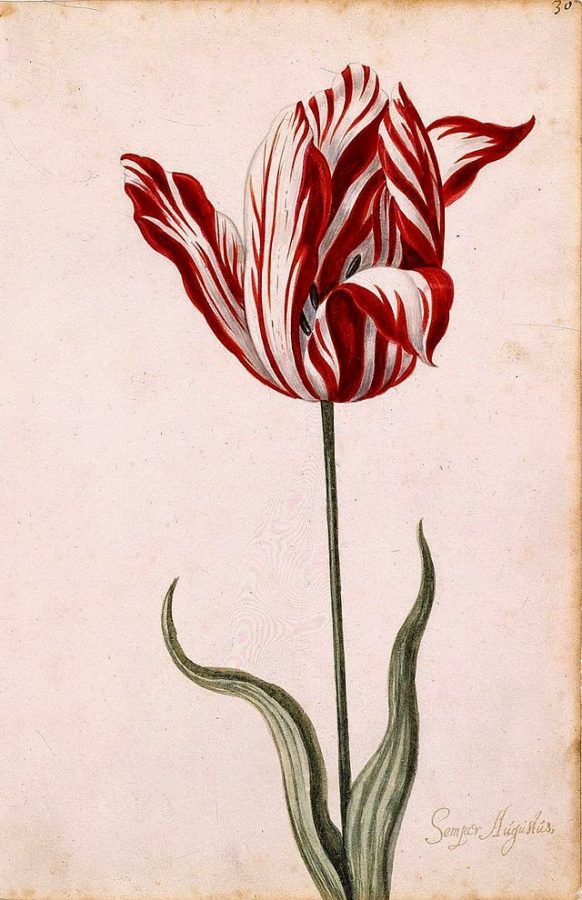Contagion
An analysis of economic crises
November 23, 2017
A tulip rises slowly from the dirt, unfurling its supple petals to reveal a heart of gold to a privileged gardener. A tulip requires months of nourishment and constant attention by its planter, but we all think that it’s well worth the effort when we gaze into its mesmerizing colors. For several weeks the tulip brings nothing but joy to those who look at it, but just as quickly as it blooms, it suddenly rots: The petals brown and harden, its stem withers, and it sags beneath its own weight. Meanwhile, we’re left to watch as our beloved blossom inexplicably dies before our very eyes. Like the lifecycle of tulips, economies move organically, growing and contracting regularly. However, just like any living being, its essence can become infected and die. Economic crises, then, are the result of a vile, widespread contagion that seeps into the minds and hearts of men and shakes the foundations of our financial institutions.
It is man’s nature to become swallowed by his dreams; thus, when he is close to attaining them, he forgets the cautionary skepticism needed to restrain dangerously blinding impulses. One of man’s most seductive dreams is that of wealth, so he falls victim to promises of a quick and easy fortune. The first stage of an economic crisis sets the trap by relaxing restrictions on people’s financial actions or by introducing a new type of financial product (usually goods or contracts that can be used to make money) (Mishkin 268). While not inherently bad, new products are unproven, so people underestimate their power and, without the necessary regulations, can blindly abuse them.
This delusion is best demonstrated on a large scale by the “Tulip Mania” that gripped the Netherlands in the early 17th Century. Amazingly, the simple tulip was able to send the surging Dutch economy into a tailspin, destroying years of remarkable prosperity. In the case of this mania, botanists competed to breed the most beautiful tulip possible, creating mixed varieties of tulips known as “cultivars” (Sooke). In their effort to do so, these scholars traded cultivars, both in the Netherlands and internationally. Betsy Wieseman, the curator of Dutch Flowers at the National Gallery, says that these scholars “started getting requests from people they didn’t know. So they started trading for money. And as that network grew and grew, it became increasingly fragile” (qtd. in Sooke).
The expanding tulip-trading network was fueled by an especially prosperous era in the Dutch economy, which was booming by the 17th Century. As a result, most people had money to throw around, so middle-class artisans and tradesmen could join Dutch aristocrats as they traded tulips (Sooke). However, as more people joined the trade, the goal shifted: Instead of trading tulips to create a stunning cultivar, people entered the market because of the dopamine rush stimulated by the risk-taking game that was unfolding, and “[f]or a modest outlay [the common man] could be drawn into the nexus of buying and speculating which, like all games, became quickly addictive” (Schama 351).
Throughout the 1620s and ‘30s, risky investors, called “speculators,” dumped their money into the market since they expected bulb prices to continue rising. “This positive-leverage-feedback mechanism add[ed] momentum to the asset-price inflation” (Bilginsoy 133), and by the prices’ peak in 1637, a single bulb of Semper Augustus, a very desirable tulip variety, cost 10,000 guilders, which was “enough to feed, clothe and house a whole Dutch family for half a lifetime, or sufficient to purchase one of the grandest homes on the most fashionable canal in Amsterdam for cash” (Sooke). Tulips were seriously overpriced relative to their intrinsic value: After all, you and I wouldn’t sell our homes to buy a flower, right?
This begs the question of how speculators could afford such extravagances. The fact of the matter is that most couldn’t, so they “borrowed huge sums of money to support this speculation and did not take into account either the tough credit terms or the high interest rates on borrowed funds” (Tong 60). Essentially, investors could engage in dangerous practices because, if they failed, they lost little to none of their own money and/or collateral relative to the skyrocketing price of tulips, so the almost-guaranteed profit was massive compared to the unlikely loss. Fueling the fire was the fact that many loans for buying tulips were backed by tulips as collateral (Tong 60). The use of tulips as collateral fed a self-perpetuating cycle in which actual money was sometimes never even used to purchase tulips, so people could enter the market without paying. This risky business was exacerbated because “[i]n their euphoric state many borrowers and lenders … fail[ed] to recognize systemic risk” (Bilginsoy 133) and deepened the mania by engaging in even more dangerous financial practices.
At the beginning of the mania, bulbs were only physically traded in the summer, when they could be pulled from the ground. However, as the market expanded, growers saw an opportunity to make more money by selling bulbs that were still in the ground, using IOU-esque “promissory notes” (Narron and Skeie). This practice essentially created a form of currency backed by tulip bulbs, as opposed to the usual gold or silver. While promissory notes were helpful in ensuring a constant flow of money regardless of the growing season (remember, that of tulips initially limited trade to the summers), they were flawed because of the serious uncertainty they introduced into the market: Using promissory notes, traders couldn’t see or inspect the bulbs they were actually trading, if they even existed. Ironically, traders didn’t even want the tulips themselves; rather, they bought promissory notes expecting to sell them later for a profit, creating a “futures market” that incentivized traders to sell their contracts before the tulips could be harvested. Mike Dash, author of Tulipomania, summarizes the mania by writing that it was “normal for florists to sell tulips they could not deliver, to buyers who did not have the cash to pay for them and who had no desire to plant them” (qtd. in Narron and Skeie).
Eventually, Dutch government officials decided to end the madness, and “[o]n 27 April 1637, the Dutch Government issued a decree that tulips and tulip bulbs … had to be physically bought and sold. Moreover, tulips had to be paid for in cash and Dutch banks could no longer accept tulips as collateral for loans” (Tong 60). Effectively, the government crippled the market for tulips: Tulip-backed promissory notes could no longer be used to purchase goods, which drove speculators out of the market and removed the supports that artificially propped the price of tulips up. Now, speculators were only left with tulips, not the profit-generating contracts that they overpaid for, and like a domino effect, every owner of a bulb sold their lot for massive losses as the price of bulbs fell below the cost at which they were initially bought. Overnight, the phenomenon that took the Dutch nation by storm suddenly dissipated, leaving only baffled speculators and a rapidly-plunging economy in February of 1637 (Sooke).
As borrowers lost money in the mania’s implosion, they were unable to pay back their lenders, who began to panic. This panic began the second stage of economic crises: Lenders (banks in more modern economies) lost incredible sums of money rapidly and en masse. As they witnessed the economy collapsing around them, lenders called in loans, often at a loss, and refused to extend new ones because they wanted to hold on to as much currency (the technical term for hard, tangible cash) as possible in such uncertain times. Now, even productive investments couldn’t be made since all of the credit in the market dried up (Mishkin 269-271), and like a tulip without water, an economy without credit cannot stand the heat for very long.
If the loss of an economy’s credit source is like a tulip going without water, then the last stage of economic crises, debt deflation, is analogous to all land becoming infertile. When prices dropped suddenly, as described previously, individual units of currency became worth more in relation to other goods. Despite its appealing nature, this movement is extremely harmful in times of economic hardship because people’s debts become worth more in real terms: Suddenly, the local clog maker who took out reasonable loans to purchase his machines several years prior to the mania could not pay his loans back. Businesses like the clog maker’s shut down and the vicious cycle of economic downturn caused by the mania spiralled out of control (Mishkin 271). Finally, the contagion had spread across the entire nation.
Ultimately, economic crises are a manifestation of the fallibility of mankind. Tempted by wealth, we foolishly think that we are immune to the very real dangers that exist everywhere in the marketplace. As shown by Tulip Mania, such hubris carries a severe cost, but the memories of its impacts are short-lived. Those who make policy decisions in the future have often not even lived through such crises, so they forget the reasons for regulations and wind up removing them in the hopes of realizing their money-fueled dreams. It would appear, then, that man is condemned to repeat his mistakes so long as he prays at the altar of wealth.
Works Cited
Bilginsoy, Cihan. A History of Financial Crises: Dreams and Follies of Expectations. Routledge, 2015.
Mishkin, Frederic S. The Economics of Money, Banking, and Financial Markets. 11th ed., Pearson, 2016. 268-271.
Narron, James, and David Skeie. “Crisis Chronicles: Tulip Mania, 1633-37.” Liberty Street Economics, Federal Reserve Bank of New York, 6 Sept. 2013.
Schama, Simon. The Embarrassment of Riches: An Interpretation of Dutch Culture in the Golden Age. Alfred A. Knopf, Inc., 1988.
Sooke, Alastair. “Tulip mania: The flowers that cost more than houses.” BBC, BBC, 3 May 2016.
Tong, Junie T. Finance and Society in 21st Century China: Chinese Culture versus Western Markets. Gower Publishing, 2011.





